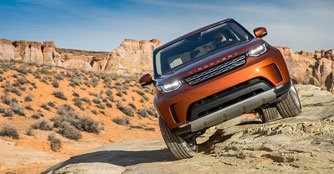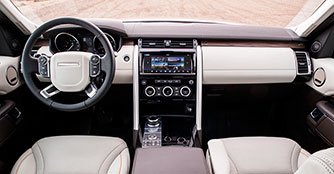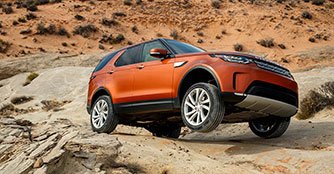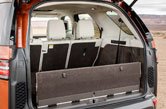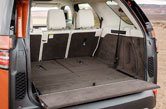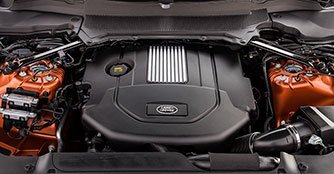Land Rover Discovery Diesel 3.0 TDV6 HSE 7-Seater (A) First Drive Review
03 Mar 2017|35,239 views
What We Like
Looks will grow on you
Extremely refined and luxurious
Seats on row two and three are electrically operated
Still a true blue Discovery
What We Dislike
Some may still prefer the manually folding seats
Two-piece tailgate a thing of the past
In any given field of industry, there are companies and people who are constantly innovating and extending the boundaries of what is known. In the world of cars, such a company is Land Rover.
Bridging the gap between a luxury and capable off-roader like the Range Rover and a hardcore back-to-basics jungle basher like the iconic Defender, the seven-seater Discovery has always been created for rough and tough drivers who aren't afraid of getting their hands dirty on weekdays while still being able to spend quality time with his family on the weekends.
But when the latest Discovery was parked at the airport in Utah, all loaded and ready for the test drive, the first natural question that popped up in my head was, "Is this still a true blue off-roader or has Land Rover been influenced by modern technologies and design cues by the more expensive Rangie just for the sake of a business case?"
The initial doubts
You sit inside the cabin, look at the car's specifications, meddle with the 10-inch touchscreen infotainment system and crank up the 3.0-litre V6 turbodiesel engine, as we did with the new Mk5 Discovery for the very first time, and the impressions of the car on first acquaintance feel very much Rangie-like.
It's at this point in time when you start thinking that it doesn't matter that the Discovery 4 has begun to feel its age, even though rivals like the Audi Q7, the BMW X5, and even the Volvo XC90 who have moved on to the full-sized SUV pie, because it almost feels like the very root of the Discovery has been 'blasphamised' by time.
But we drive on, kilometre after kilometre, until it is time for some off-road activities. Amongst the red rocks and chocolaty mud, the Discovery looks and feels completely at home. The real feeling of solidity built around the driver, along with its raft of sophisticated off-road technology at its disposal via the Terrain Response 2, low range gearbox and the All-Terrain Progress Control (ATPC) that takes over the footwork and leaving you only to steer further, enhance this very fact. Moving up and down, front and side in off-road terrains doesn't seem like something worth shouting about, really.
Bridging the gap between a luxury and capable off-roader like the Range Rover and a hardcore back-to-basics jungle basher like the iconic Defender, the seven-seater Discovery has always been created for rough and tough drivers who aren't afraid of getting their hands dirty on weekdays while still being able to spend quality time with his family on the weekends.
But when the latest Discovery was parked at the airport in Utah, all loaded and ready for the test drive, the first natural question that popped up in my head was, "Is this still a true blue off-roader or has Land Rover been influenced by modern technologies and design cues by the more expensive Rangie just for the sake of a business case?"
The initial doubts
You sit inside the cabin, look at the car's specifications, meddle with the 10-inch touchscreen infotainment system and crank up the 3.0-litre V6 turbodiesel engine, as we did with the new Mk5 Discovery for the very first time, and the impressions of the car on first acquaintance feel very much Rangie-like.
It's at this point in time when you start thinking that it doesn't matter that the Discovery 4 has begun to feel its age, even though rivals like the Audi Q7, the BMW X5, and even the Volvo XC90 who have moved on to the full-sized SUV pie, because it almost feels like the very root of the Discovery has been 'blasphamised' by time.
But we drive on, kilometre after kilometre, until it is time for some off-road activities. Amongst the red rocks and chocolaty mud, the Discovery looks and feels completely at home. The real feeling of solidity built around the driver, along with its raft of sophisticated off-road technology at its disposal via the Terrain Response 2, low range gearbox and the All-Terrain Progress Control (ATPC) that takes over the footwork and leaving you only to steer further, enhance this very fact. Moving up and down, front and side in off-road terrains doesn't seem like something worth shouting about, really.
What can the Discovery brag about, then?
The off-road instructor stands calmly in front me and tells me to follow his every hand signal as we commenced climbing a huge boulder. Two wheels up, a few turns of the steering, and then three wheels on the boulder, with one wheel left unconnected to anything. Ah, still a common thing to experience in an off-road section. I've been in worse situations.
Then I realised that is the easy part. Minutes later, the instructor comes to me and tells me to head towards the ramp because there's a need to drive up over the area of what I can only see as impossible. The made-do wooden ramps are clearly there as a form of stepping stones, nothing more. If the Discovery 5 can conquer this, then penguins can fly. I stare at him with utter disbelief but pretend to remain calm. Perhaps, at that very moment, the only thing that isn't pretending is the Discovery itself.
His instructions are crystal clear and it should be to someone who is almost unsure if the SUV weighing close to three tonnes can actually save or kill me. He instructs, "Whatever you do, keep your foot down to the gas like never before and make sure the steering wheel is straight, no matter what."
Despite the commanding driving position, I can only see blue skies as I floor the accelerator and fight to keep my hands straight as the car begins to tilt upwards and I attempt to conquer an impossible situation. Constant roaring from the V6 diesel powerplant and seconds later, I am still alive and breathing without a single scratch on me, and with all four wheels touching the ground. Sweet Jesus, I made it.
The off-road instructor stands calmly in front me and tells me to follow his every hand signal as we commenced climbing a huge boulder. Two wheels up, a few turns of the steering, and then three wheels on the boulder, with one wheel left unconnected to anything. Ah, still a common thing to experience in an off-road section. I've been in worse situations.
Then I realised that is the easy part. Minutes later, the instructor comes to me and tells me to head towards the ramp because there's a need to drive up over the area of what I can only see as impossible. The made-do wooden ramps are clearly there as a form of stepping stones, nothing more. If the Discovery 5 can conquer this, then penguins can fly. I stare at him with utter disbelief but pretend to remain calm. Perhaps, at that very moment, the only thing that isn't pretending is the Discovery itself.
His instructions are crystal clear and it should be to someone who is almost unsure if the SUV weighing close to three tonnes can actually save or kill me. He instructs, "Whatever you do, keep your foot down to the gas like never before and make sure the steering wheel is straight, no matter what."
Despite the commanding driving position, I can only see blue skies as I floor the accelerator and fight to keep my hands straight as the car begins to tilt upwards and I attempt to conquer an impossible situation. Constant roaring from the V6 diesel powerplant and seconds later, I am still alive and breathing without a single scratch on me, and with all four wheels touching the ground. Sweet Jesus, I made it.
 |
Hold on a second. Is it still a Discovery at heart then?
Land Rover has ensured that the Discovery earned its credible stripes and the impressions of this are only reinforced when you start meddling with the five seats at the rear of the car. This is when you'll start realising the Disco is essentially still that functional seven-seater that in unfounded in a Rangie.
1,137 litres of space readily available with row three folded (left) and 2,406 litres with rows two and three folded (right)
Meeting form with function, the seats on rows two and three can now be electrically operated in 14 seconds via a smartphone app, the 10-inch touchscreen, or through the straightfoward buttons located at the boot area or on the seats. Have all seats in place and the car will genuinely hold seven adults with suffcient head and legroom while still providing a usable 258 litres of luggage space.
This space can be increased to a whopping 2,406 litres should you choose to fold down both rows two and three, which will easily be a bed on wheels for two full-sized Asian adults.
Not forgetting the 21 separate storage areas that make up 45 litres of space, the availability of USB ports on every seat as well as the electrical one-piece tailgate (replacing the split tailgate from its predecessor) that can support up to 300kg, this SUV is as versatile as it can be, which is every bit what a Discovery should and always be known for.
It's the best of both worlds
Just as impressive as it is off-road is the Mk5 Disco's tarmac manners. Tagged with a 3.0-litre V6 turbodiesel under the bonnet that's mated to a ZF eight-speed automatic gearbox, the car will take a respectable 8.1 seconds to shoot from nought to 100km/h. What's astounding isn't the figure that suggest its quickness, but rather the strong sense of linearity it displays.
Unlike turbodiesels, where a surge of torque sends your neck towards the head rest when you pedal to the metal, the Discovery delivers the goods - all 258bhp and 600Nm of torque - in a rather soft and smooth manner. While many may detest such a characteristic, the car does benefit in terms of higher levels of refinement from this.
Land Rover has ensured that the Discovery earned its credible stripes and the impressions of this are only reinforced when you start meddling with the five seats at the rear of the car. This is when you'll start realising the Disco is essentially still that functional seven-seater that in unfounded in a Rangie.
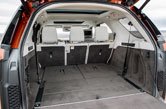 | 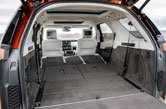 |
Meeting form with function, the seats on rows two and three can now be electrically operated in 14 seconds via a smartphone app, the 10-inch touchscreen, or through the straightfoward buttons located at the boot area or on the seats. Have all seats in place and the car will genuinely hold seven adults with suffcient head and legroom while still providing a usable 258 litres of luggage space.
This space can be increased to a whopping 2,406 litres should you choose to fold down both rows two and three, which will easily be a bed on wheels for two full-sized Asian adults.
Not forgetting the 21 separate storage areas that make up 45 litres of space, the availability of USB ports on every seat as well as the electrical one-piece tailgate (replacing the split tailgate from its predecessor) that can support up to 300kg, this SUV is as versatile as it can be, which is every bit what a Discovery should and always be known for.
It's the best of both worlds
Just as impressive as it is off-road is the Mk5 Disco's tarmac manners. Tagged with a 3.0-litre V6 turbodiesel under the bonnet that's mated to a ZF eight-speed automatic gearbox, the car will take a respectable 8.1 seconds to shoot from nought to 100km/h. What's astounding isn't the figure that suggest its quickness, but rather the strong sense of linearity it displays.
Unlike turbodiesels, where a surge of torque sends your neck towards the head rest when you pedal to the metal, the Discovery delivers the goods - all 258bhp and 600Nm of torque - in a rather soft and smooth manner. While many may detest such a characteristic, the car does benefit in terms of higher levels of refinement from this.
On long and empty stretches of roads, where going past speed limits are attempted, there are no signs showing that the Disco is diesel-powered while external noises are kept well at bay.
That said, the car isn't without flaws. Given its dimensions of 4,970mm x 2,073mm x 2,220mm (L x W x H), the SUV can't battle the law of physics around winding roads. What it can do, however, is allow you to steer the car with confidence at reasonable speeds without feeling like you're going to roll off and down the cliff.

 It's hard to tell that the car sports a diesel engine even when you charge down empty stretches of roads
It's hard to tell that the car sports a diesel engine even when you charge down empty stretches of roads
You had me at Sweet Jesus
Being based on the Range Rover and the Range Rover Sport means that the new Disco's architecture is made up mainly of aluminium, which has allowed it to shed 480kg. This can only mean that the car will return lower emissions as well as improve its fuel consumption.
That aside, the Disco you see here is clearly designed to widen its audience, and has undoubtedly been engineered to be more comfortable without losing its under-the-skin capabilities. Decades have passed and the Discovery nameplate, once only known to a niche audience who frequented off-roads, should have no qualms being known to everyone when it arrives this August in Singapore.
When you look at the innovation and the extension of boundaries that Land Rover has accomplished thus far, the prospects that still lie ahead of the carmaker seem truly boundless.
The 3.0-litre V6 turbodiesel-powered car clad in Namib Orange here should set you back at about $323,900, with an OMV of approximately $70,000.
That said, the car isn't without flaws. Given its dimensions of 4,970mm x 2,073mm x 2,220mm (L x W x H), the SUV can't battle the law of physics around winding roads. What it can do, however, is allow you to steer the car with confidence at reasonable speeds without feeling like you're going to roll off and down the cliff.

You had me at Sweet Jesus
Being based on the Range Rover and the Range Rover Sport means that the new Disco's architecture is made up mainly of aluminium, which has allowed it to shed 480kg. This can only mean that the car will return lower emissions as well as improve its fuel consumption.
That aside, the Disco you see here is clearly designed to widen its audience, and has undoubtedly been engineered to be more comfortable without losing its under-the-skin capabilities. Decades have passed and the Discovery nameplate, once only known to a niche audience who frequented off-roads, should have no qualms being known to everyone when it arrives this August in Singapore.
When you look at the innovation and the extension of boundaries that Land Rover has accomplished thus far, the prospects that still lie ahead of the carmaker seem truly boundless.
The 3.0-litre V6 turbodiesel-powered car clad in Namib Orange here should set you back at about $323,900, with an OMV of approximately $70,000.
What We Like
Looks will grow on you
Extremely refined and luxurious
Seats on row two and three are electrically operated
Still a true blue Discovery
What We Dislike
Some may still prefer the manually folding seats
Two-piece tailgate a thing of the past
In any given field of industry, there are companies and people who are constantly innovating and extending the boundaries of what is known. In the world of cars, such a company is Land Rover.
Bridging the gap between a luxury and capable off-roader like the Range Rover and a hardcore back-to-basics jungle basher like the iconic Defender, the seven-seater Discovery has always been created for rough and tough drivers who aren't afraid of getting their hands dirty on weekdays while still being able to spend quality time with his family on the weekends.
But when the latest Discovery was parked at the airport in Utah, all loaded and ready for the test drive, the first natural question that popped up in my head was, "Is this still a true blue off-roader or has Land Rover been influenced by modern technologies and design cues by the more expensive Rangie just for the sake of a business case?"
The initial doubts
You sit inside the cabin, look at the car's specifications, meddle with the 10-inch touchscreen infotainment system and crank up the 3.0-litre V6 turbodiesel engine, as we did with the new Mk5 Discovery for the very first time, and the impressions of the car on first acquaintance feel very much Rangie-like.
It's at this point in time when you start thinking that it doesn't matter that the Discovery 4 has begun to feel its age, even though rivals like the Audi Q7, the BMW X5, and even the Volvo XC90 who have moved on to the full-sized SUV pie, because it almost feels like the very root of the Discovery has been 'blasphamised' by time.
But we drive on, kilometre after kilometre, until it is time for some off-road activities. Amongst the red rocks and chocolaty mud, the Discovery looks and feels completely at home. The real feeling of solidity built around the driver, along with its raft of sophisticated off-road technology at its disposal via the Terrain Response 2, low range gearbox and the All-Terrain Progress Control (ATPC) that takes over the footwork and leaving you only to steer further, enhance this very fact. Moving up and down, front and side in off-road terrains doesn't seem like something worth shouting about, really.
Bridging the gap between a luxury and capable off-roader like the Range Rover and a hardcore back-to-basics jungle basher like the iconic Defender, the seven-seater Discovery has always been created for rough and tough drivers who aren't afraid of getting their hands dirty on weekdays while still being able to spend quality time with his family on the weekends.
But when the latest Discovery was parked at the airport in Utah, all loaded and ready for the test drive, the first natural question that popped up in my head was, "Is this still a true blue off-roader or has Land Rover been influenced by modern technologies and design cues by the more expensive Rangie just for the sake of a business case?"
The initial doubts
You sit inside the cabin, look at the car's specifications, meddle with the 10-inch touchscreen infotainment system and crank up the 3.0-litre V6 turbodiesel engine, as we did with the new Mk5 Discovery for the very first time, and the impressions of the car on first acquaintance feel very much Rangie-like.
It's at this point in time when you start thinking that it doesn't matter that the Discovery 4 has begun to feel its age, even though rivals like the Audi Q7, the BMW X5, and even the Volvo XC90 who have moved on to the full-sized SUV pie, because it almost feels like the very root of the Discovery has been 'blasphamised' by time.
But we drive on, kilometre after kilometre, until it is time for some off-road activities. Amongst the red rocks and chocolaty mud, the Discovery looks and feels completely at home. The real feeling of solidity built around the driver, along with its raft of sophisticated off-road technology at its disposal via the Terrain Response 2, low range gearbox and the All-Terrain Progress Control (ATPC) that takes over the footwork and leaving you only to steer further, enhance this very fact. Moving up and down, front and side in off-road terrains doesn't seem like something worth shouting about, really.
What can the Discovery brag about, then?
The off-road instructor stands calmly in front me and tells me to follow his every hand signal as we commenced climbing a huge boulder. Two wheels up, a few turns of the steering, and then three wheels on the boulder, with one wheel left unconnected to anything. Ah, still a common thing to experience in an off-road section. I've been in worse situations.
Then I realised that is the easy part. Minutes later, the instructor comes to me and tells me to head towards the ramp because there's a need to drive up over the area of what I can only see as impossible. The made-do wooden ramps are clearly there as a form of stepping stones, nothing more. If the Discovery 5 can conquer this, then penguins can fly. I stare at him with utter disbelief but pretend to remain calm. Perhaps, at that very moment, the only thing that isn't pretending is the Discovery itself.
His instructions are crystal clear and it should be to someone who is almost unsure if the SUV weighing close to three tonnes can actually save or kill me. He instructs, "Whatever you do, keep your foot down to the gas like never before and make sure the steering wheel is straight, no matter what."
Despite the commanding driving position, I can only see blue skies as I floor the accelerator and fight to keep my hands straight as the car begins to tilt upwards and I attempt to conquer an impossible situation. Constant roaring from the V6 diesel powerplant and seconds later, I am still alive and breathing without a single scratch on me, and with all four wheels touching the ground. Sweet Jesus, I made it.
The off-road instructor stands calmly in front me and tells me to follow his every hand signal as we commenced climbing a huge boulder. Two wheels up, a few turns of the steering, and then three wheels on the boulder, with one wheel left unconnected to anything. Ah, still a common thing to experience in an off-road section. I've been in worse situations.
Then I realised that is the easy part. Minutes later, the instructor comes to me and tells me to head towards the ramp because there's a need to drive up over the area of what I can only see as impossible. The made-do wooden ramps are clearly there as a form of stepping stones, nothing more. If the Discovery 5 can conquer this, then penguins can fly. I stare at him with utter disbelief but pretend to remain calm. Perhaps, at that very moment, the only thing that isn't pretending is the Discovery itself.
His instructions are crystal clear and it should be to someone who is almost unsure if the SUV weighing close to three tonnes can actually save or kill me. He instructs, "Whatever you do, keep your foot down to the gas like never before and make sure the steering wheel is straight, no matter what."
Despite the commanding driving position, I can only see blue skies as I floor the accelerator and fight to keep my hands straight as the car begins to tilt upwards and I attempt to conquer an impossible situation. Constant roaring from the V6 diesel powerplant and seconds later, I am still alive and breathing without a single scratch on me, and with all four wheels touching the ground. Sweet Jesus, I made it.
Hold on a second. Is it still a Discovery at heart then?
Land Rover has ensured that the Discovery earned its credible stripes and the impressions of this are only reinforced when you start meddling with the five seats at the rear of the car. This is when you'll start realising the Disco is essentially still that functional seven-seater that in unfounded in a Rangie.
Meeting form with function, the seats on rows two and three can now be electrically operated in 14 seconds via a smartphone app, the 10-inch touchscreen, or through the straightfoward buttons located at the boot area or on the seats. Have all seats in place and the car will genuinely hold seven adults with suffcient head and legroom while still providing a usable 258 litres of luggage space.
This space can be increased to a whopping 2,406 litres should you choose to fold down both rows two and three, which will easily be a bed on wheels for two full-sized Asian adults.
Not forgetting the 21 separate storage areas that make up 45 litres of space, the availability of USB ports on every seat as well as the electrical one-piece tailgate (replacing the split tailgate from its predecessor) that can support up to 300kg, this SUV is as versatile as it can be, which is every bit what a Discovery should and always be known for.
It's the best of both worlds
Just as impressive as it is off-road is the Mk5 Disco's tarmac manners. Tagged with a 3.0-litre V6 turbodiesel under the bonnet that's mated to a ZF eight-speed automatic gearbox, the car will take a respectable 8.1 seconds to shoot from nought to 100km/h. What's astounding isn't the figure that suggest its quickness, but rather the strong sense of linearity it displays.
Unlike turbodiesels, where a surge of torque sends your neck towards the head rest when you pedal to the metal, the Discovery delivers the goods - all 258bhp and 600Nm of torque - in a rather soft and smooth manner. While many may detest such a characteristic, the car does benefit in terms of higher levels of refinement from this.
Land Rover has ensured that the Discovery earned its credible stripes and the impressions of this are only reinforced when you start meddling with the five seats at the rear of the car. This is when you'll start realising the Disco is essentially still that functional seven-seater that in unfounded in a Rangie.
Meeting form with function, the seats on rows two and three can now be electrically operated in 14 seconds via a smartphone app, the 10-inch touchscreen, or through the straightfoward buttons located at the boot area or on the seats. Have all seats in place and the car will genuinely hold seven adults with suffcient head and legroom while still providing a usable 258 litres of luggage space.
This space can be increased to a whopping 2,406 litres should you choose to fold down both rows two and three, which will easily be a bed on wheels for two full-sized Asian adults.
Not forgetting the 21 separate storage areas that make up 45 litres of space, the availability of USB ports on every seat as well as the electrical one-piece tailgate (replacing the split tailgate from its predecessor) that can support up to 300kg, this SUV is as versatile as it can be, which is every bit what a Discovery should and always be known for.
It's the best of both worlds
Just as impressive as it is off-road is the Mk5 Disco's tarmac manners. Tagged with a 3.0-litre V6 turbodiesel under the bonnet that's mated to a ZF eight-speed automatic gearbox, the car will take a respectable 8.1 seconds to shoot from nought to 100km/h. What's astounding isn't the figure that suggest its quickness, but rather the strong sense of linearity it displays.
Unlike turbodiesels, where a surge of torque sends your neck towards the head rest when you pedal to the metal, the Discovery delivers the goods - all 258bhp and 600Nm of torque - in a rather soft and smooth manner. While many may detest such a characteristic, the car does benefit in terms of higher levels of refinement from this.
On long and empty stretches of roads, where going past speed limits are attempted, there are no signs showing that the Disco is diesel-powered while external noises are kept well at bay.
That said, the car isn't without flaws. Given its dimensions of 4,970mm x 2,073mm x 2,220mm (L x W x H), the SUV can't battle the law of physics around winding roads. What it can do, however, is allow you to steer the car with confidence at reasonable speeds without feeling like you're going to roll off and down the cliff.
You had me at Sweet Jesus
Being based on the Range Rover and the Range Rover Sport means that the new Disco's architecture is made up mainly of aluminium, which has allowed it to shed 480kg. This can only mean that the car will return lower emissions as well as improve its fuel consumption.
That aside, the Disco you see here is clearly designed to widen its audience, and has undoubtedly been engineered to be more comfortable without losing its under-the-skin capabilities. Decades have passed and the Discovery nameplate, once only known to a niche audience who frequented off-roads, should have no qualms being known to everyone when it arrives this August in Singapore.
When you look at the innovation and the extension of boundaries that Land Rover has accomplished thus far, the prospects that still lie ahead of the carmaker seem truly boundless.
The 3.0-litre V6 turbodiesel-powered car clad in Namib Orange here should set you back at about $323,900, with an OMV of approximately $70,000.
That said, the car isn't without flaws. Given its dimensions of 4,970mm x 2,073mm x 2,220mm (L x W x H), the SUV can't battle the law of physics around winding roads. What it can do, however, is allow you to steer the car with confidence at reasonable speeds without feeling like you're going to roll off and down the cliff.
You had me at Sweet Jesus
Being based on the Range Rover and the Range Rover Sport means that the new Disco's architecture is made up mainly of aluminium, which has allowed it to shed 480kg. This can only mean that the car will return lower emissions as well as improve its fuel consumption.
That aside, the Disco you see here is clearly designed to widen its audience, and has undoubtedly been engineered to be more comfortable without losing its under-the-skin capabilities. Decades have passed and the Discovery nameplate, once only known to a niche audience who frequented off-roads, should have no qualms being known to everyone when it arrives this August in Singapore.
When you look at the innovation and the extension of boundaries that Land Rover has accomplished thus far, the prospects that still lie ahead of the carmaker seem truly boundless.
The 3.0-litre V6 turbodiesel-powered car clad in Namib Orange here should set you back at about $323,900, with an OMV of approximately $70,000.
Thank You For Your Subscription.




























